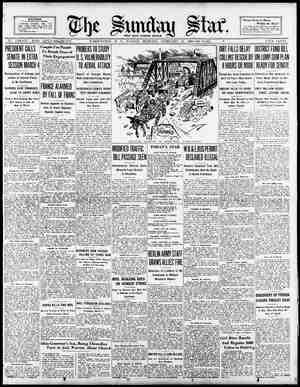Casper Daily Tribune Newspaper, February 15, 1925, Page 17
You have reached the hourly page view limit. Unlock higher limit to our entire archive!
Subscribers enjoy higher page view limit, downloads, and exclusive features.
Che Casper Daily Cribune SUNDAY, FEBRUARY 15, 1928 EAGE THREE AAA cnn 22 scram — — eee es nn nee eee tii = zl Keep the Wheels of Business Moving Forward! What do we citizens of Wyoming know about our Petro- leum Industry? : z Do we realize what this great business is doing towards contributing to the advancement of the State and our commu- nities? Are we aware of the fact that continuous employment of men at fair wages keeps the wheels of business progress in mo- tion and thus.creates happy and contented communities? Do we recognize that as a result of the investment of capi- tal to produce, refine and market petroleum products, that - workers are enabled to maintain comfortable homes in which to live, have food, clothing, recreation and educational advan- tages? Do we realize that these same workers buy land, lumber and building material, pay local and state taxes, support civic enterprises, buy household furnishings, clothes, meats, vegetables, dairy products, groceries, drugs and other necessi- ties, attend dances, picture shows and enjoy other forms of amusement, support and attend church, rear and support fam- ilies, and in this manner contribute to the support of every; de- pendable and worth-while business and ‘industry in their re- spective communities? Is it not true that the oil industry in Wyoming is benefit- ting the State and all of its people, and that this is possible only by fair and constructive business management, through which policy alone it is able to secure the funds to continue its work? a L WHY SHOULD WE NOT BE INFORMED? What great business-during the past ten years has lifted Wyoming from a frontier state to one of afflu- ence and position as an industrial: state? The production of crude oil and its manu- facture into gasoline, kerosene, lubricants, fuel oil and asphalt. What other. by-products are-made from Wyoming crade oil? Medicinal oils, candles, petrolatums, par- affine wax, coke and similar products. How many men tn Wyoming are employed in the production and refining of crude oil? Approximately 12,000 in 1924, How much money did they recetve in wages? The payrolls amounted to nearly $20,000,- 000, a large percentage going to workers of Natrona County. Who owrs the lands from which oil is produced in Wyoming? . It is estimated that about 85 per cent of oil produced in the State comes from lands owned by the United States Government, and the re- maining 15 per cent from lands owned by State and private holders. W hat benefit is derived by the United States Gov- ernment from its Wyoming oil lands? Under the Federal Leasing Act, the Goy- ernment is paid a royalty of from 124 to 331-3 barrels out of every 100 barrels of oil produced from wells on its lands, of which amount 5214 per cent goes into the Federal reclamation fund, 3714 per cent is returned to the State of Wyoming in place of taxes on Government lands and 10 per cent goes for Government ex- penses in administering the Leasing Act. What did the State of Wyoming receive from Government royalty oil during the last fiscal year? For the one year period ending June 30, 1924, Wyoming state schools, university and state highway funds received as their share from the government a total of $4,223,298.63. How many wildcat wells were drilled in Wyo- ming in 1924, and what was their approximate cost? There were 41 wildcat wells drilled costing $650,000, with possibly only one commercial* oil field found—Rex Lake. How many wildcat wells were drilled prior to 19242 There were 202 wildcat wells drilled in Wyoming prior to that time in which 19 oil and gas fields were found which cost approximate- ly $20,000,000, or $1,050,000 per field. As it re- quires several dry holes to determine the pro- ductive area of a known field, it is calculated that this knowledge costs $1,250,000 for each field and it is found that before a profit can be realized there must be expended at least $2,300,000 in finding and defining an oil field. Why is wildcatting necessary? To provide the industry and the public with assured sources of supply for, the future. Where do the funds come from to carry on wild- catting? They come only after Government and State royalties have been paid, after Federal, State, County, School District and Municipal taxes; after payment of wages, new construc- tion and replacement expense; then if there is anything left it can be applied to wildcat- ting. ~ Has gasoline been selling high in the past 10 years compared with other necessities consumed by the gen- eral public? Government reports show that gasoline has remained at the bottom of the list among all commodities. Taking 100 as a basis, it is found that all farm commodities in 1923, for in- stance, reached an average of 154, while gaso- line was only 112, being 27 points less than the next lowest commodity and 42 points below the average of all commodities. Within the last few weeks only have crude oil and gaso- line started to follow the lead of other neces- sities. Can the oil industry with its thousands of employes in Wyoming prove beneficial to the farmer, stock grower and producer of foodstuffs and supplies? It can. By mutual co-operation and fair treatment.so that all lines of business in Wyo- ming ‘may thrive, the oil industry in such a movement can and will be a large factor in sus- taining a prosperous and energetic citizenship which cannot fail to keep Wyoming in the front rank of commercial progress. The Midwest Refining Company eee A E a = ge CU EEL Ci iin nnn iiss


